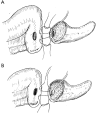Development and validation of a novel pancreaticojejunostomy strategy based on the anatomical location of the main pancreatic duct that can reduce the risk of postoperative pancreatic fistula after pancreatoduodenectomy
- PMID: 39544981
- PMCID: PMC11558298
- DOI: 10.21037/gs-24-235
Development and validation of a novel pancreaticojejunostomy strategy based on the anatomical location of the main pancreatic duct that can reduce the risk of postoperative pancreatic fistula after pancreatoduodenectomy
Abstract
Background: Postoperative pancreatic fistula (POPF) is a common complication after pancreaticoduodenectomy (PD). The effect of the location of the main pancreatic duct on POPF development is not completely elucidated. This study aimed to investigate the association between the location of the main pancreatic duct and POPF, and the effect of pancreaticojejunostomy based on the location of the main pancreatic duct on the risk of POPF.
Methods: This retrospective study enrolled 871 patients who underwent PD between January 2018 and December 2021. Logistic regression analysis was performed to identify the independent risk factors associated with POPF. Predictive performance was evaluated using the receiver operating characteristic curves. In addition, a novel pancreaticojejunostomy strategy that could reduce the risk of POPF was adopted.
Results: Based on the multivariate analysis, the pancreatic texture and the location of the main pancreatic duct were the independent risk factors of POPF. A threshold ratio of 0.397 was used to distinguish the central from the eccentric pancreatic ducts. Notably, patients with the central pancreatic duct had a significantly lower incidence rate of POPF than those with the eccentric pancreatic ducts (10.6% vs. 44.8%, P<0.001). The novel group exhibited a significantly lower incidence rate of POPF than the conventional group (13.7% vs. 23.0%, P=0.02), and the incidence rate of other complications was not high.
Conclusions: The location of the main pancreatic duct is associated with POPF development. However, implementing the novel pancreaticojejunostomy approach can effectively reduce the risk of POPF while ensuring safety.
Keywords: Main pancreatic duct; pancreaticoduodenectomy (PD); pancreaticojejunostomy; postoperative pancreatic fistula (POPF).
2024 AME Publishing Company. All rights reserved.
Conflict of interest statement
Conflicts of Interest: All authors have completed the ICMJE uniform disclosure form (available at https://gs.amegroups.com/article/view/10.21037/gs-24-235/coif). The authors have no conflicts of interest to declare.
Figures





Similar articles
-
A duct-to-mucosa pancreaticojejunostomy for small main pancreatic duct and soft pancreas in minimally invasive pancreaticoduodenectomy.Surg Endosc. 2023 May;37(5):3567-3579. doi: 10.1007/s00464-022-09830-6. Epub 2023 Jan 9. Surg Endosc. 2023. PMID: 36624217 Free PMC article.
-
[The clinical value of pancreatic fistula risk predicting system after pancreaticoduodenectomy].Zhonghua Wai Ke Za Zhi. 2015 Jun 1;53(6):410-4. Zhonghua Wai Ke Za Zhi. 2015. PMID: 26359052 Chinese.
-
Continuous versus interrupted suture techniques of pancreaticojejunostomy after pancreaticoduodenectomy.J Surg Res. 2015 Feb;193(2):590-7. doi: 10.1016/j.jss.2014.07.066. Epub 2014 Aug 5. J Surg Res. 2015. PMID: 25175768
-
Papillary-like main pancreatic duct invaginated pancreaticojejunostomy versus duct-to-mucosa pancreaticojejunostomy after pancreaticoduodenectomy: A prospective randomized trial.Surgery. 2015 Nov;158(5):1211-8. doi: 10.1016/j.surg.2015.04.020. Epub 2015 May 30. Surgery. 2015. PMID: 26036878 Clinical Trial.
-
A web-based overview, systematic review and meta-analysis of pancreatic anastomosis techniques following pancreatoduodenectomy.HPB (Oxford). 2018 Sep;20(9):777-785. doi: 10.1016/j.hpb.2018.03.003. HPB (Oxford). 2018. PMID: 29773356
References
LinkOut - more resources
Full Text Sources
